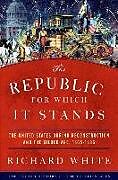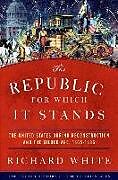The Republic for Which It Stands
Einband:
Fester Einband
EAN:
9780199735815
Untertitel:
The United States During Reconstruction and the Gilded Age, 1865-1896
Genre:
Geschichte
Autor:
Richard White
Herausgeber:
Oxford University Press, USA
Anzahl Seiten:
968
Erscheinungsdatum:
01.09.2017
ISBN:
978-0-19-973581-5
This union of an iconoclastic historian and an icon-making series has produced a surprising, ultimately fulfilling match of author and age ... White's accomplishment in this thickly researched, energetically written, and at times mordantly funny book, is to find the newness and meaning in people and events that ... have been more familiar than understood.
Autorentext
Richard White is Margaret Byrne Professor of American History at Stanford University. He is the author of numerous prize-winning books, including Railroaded: The Transcontinentals and the Making of Modern America, The Middle Ground: Indians, Empires, and Republics in the Great Lakes Region, 1650-1815, and "It's Your Misfortune and None of My Own": A New History of the American West. He is a recipient of a MacArthur Fellowship, a Guggenheim Fellowship, and a Mellon Distinguished Scholar Award, among other awards.
Klappentext
The newest volume in the Oxford History of the United States series, The Republic for Which It Stands argues that the Gilded Age, along with Reconstruction its conflicts, rapid and disorienting change, hopes and fears formed the template of American modernity.
Zusammenfassung
The Oxford History of the United States is the most respected multivolume history of the American nation. In the newest volume in the series, The Republic for Which It Stands, acclaimed historian Richard White offers a fresh and integrated interpretation of Reconstruction and the Gilded Age as the seedbed of modern America. At the end of the Civil War the leaders and citizens of the victorious North envisioned the country's future as a free-labor republic, with a homogenous citizenry, both black and white. The South and West were to be reconstructed in the image of the North. Thirty years later Americans occupied an unimagined world. The unity that the Civil War supposedly secured had proved ephemeral. The country was larger, richer, and more extensive, but also more diverse. Life spans were shorter, and physical well-being had diminished, due to disease and hazardous working conditions. Independent producers had become wage earners. The country was Catholic and Jewish as well as Protestant, and increasingly urban and industrial. The "dangerous" classes of the very rich and poor expanded, and deep differences-ethnic, racial, religious, economic, and political-divided society. The corruption that gave the Gilded Age its name was pervasive. These challenges also brought vigorous efforts to secure economic, moral, and cultural reforms. Real change-technological, cultural, and political-proliferated from below more than emerging from political leadership. Americans, mining their own traditions and borrowing ideas, produced creative possibilities for overcoming the crises that threatened their country. In a work as dramatic and colorful as the era it covers, White narrates the conflicts and paradoxes of these decades of disorienting change and mounting unrest, out of which emerged a modern nation whose characteristics resonate with the present day.
Inhalt
List of Maps
Editor's Introduction
Introduction
Part I: Reconstructing the Nation
Prologue: Mourning Lincoln
Chapter One: In the Wake of War
Chapter Two: Radical Reconstruction
Chapter Three: The Greater Reconstruction
Chapter Four: Home
Chapter Five: Gilded Liberals
Chapter Six: Triumph of Wage Labor
Chapter Seven: Panic
Chapter Eight: Beginning a Second Century
Part II: The Quest for Prosperity
Chapter Nine: Years of Violence
Chapter Ten: The Party of Prosperity
Chapter Eleven: People in Motion
Chapter Twelve: Liberal Orthodoxy and Radical Opinions
Chapter Thirteen: Dying for Progress
Chapter Fourteen: The Great Upheaval
Chapter Fifteen: Reform
Chapter Sixteen: Westward the Course of Reform
Chapter Seventeen: The Center Fails to Hold
Chapter Eighteen: The Poetry of a Pound of Steel
Part III: The Crisis Arrives
Chapter Nineteen: The Other Half
Chapter Twenty: Dystopian and Utopian America
Chapter Twenty-one: The Great Depression
Chapter Twenty-two: Things Fall Apart
Chapter Twenty-three: An Era Ends
Conclusion
Bibliographic Essay
Index

Leider konnten wir für diesen Artikel keine Preise ermitteln ...
billigbuch.ch sucht jetzt für Sie die besten Angebote ...
Die aktuellen Verkaufspreise von 6 Onlineshops werden in Realtime abgefragt.
Sie können das gewünschte Produkt anschliessend direkt beim Anbieter Ihrer Wahl bestellen.
Loading...
Die aktuellen Verkaufspreise von 6 Onlineshops werden in Realtime abgefragt.
Sie können das gewünschte Produkt anschliessend direkt beim Anbieter Ihrer Wahl bestellen.
| # | Onlineshop | Preis CHF | Versand CHF | Total CHF | ||
|---|---|---|---|---|---|---|
| 1 | Seller | 0.00 | 0.00 | 0.00 |
